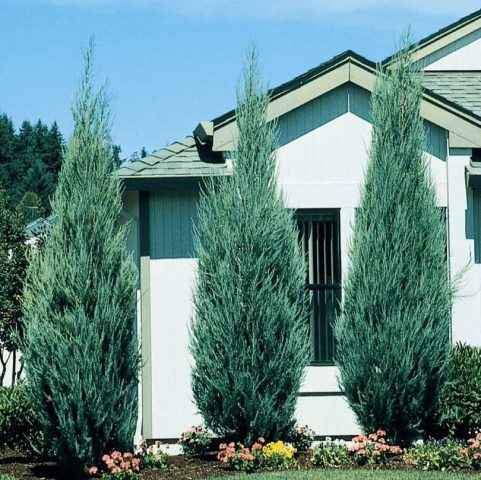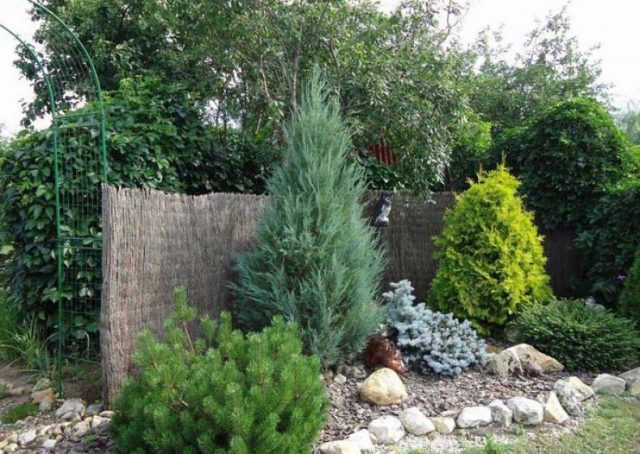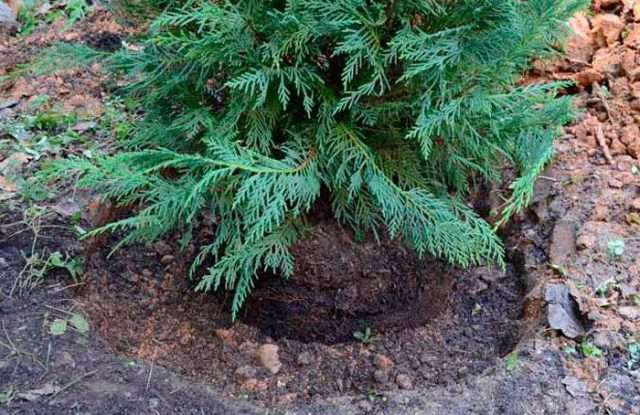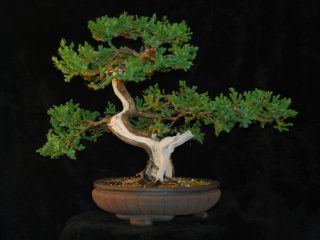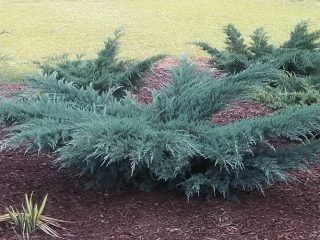Content
Various trees and shrubs are used to create a unique garden design. Juniper Skyrocket is widely used, as a plant that soars vertically upward looks great among horticultural crops. There is another advantage of this evergreen rocky juniper Skyrocket (Juniperus scopulorum Skyrocket) - by releasing phytoncides, the plant cleans the air of harmful impurities.
Description of Skyrocket Juniper
In the wild, relatives of the plant can be found on the mountain slopes of the United States of America and Mexico. It is an evergreen coniferous culture, hardy and unpretentious to the soil. It was this wild juniper that was taken as the basis for the creation of the rocky Skyrocket variety in the last decade of the 19th century.
Attention should be paid to the peculiarities of the height and growth rate of the Skyrocket juniper: in 20 years the plant grows up to 8 m.In natural nature, the juniper can reach 20 m.
An evergreen coniferous tree is very beautiful in appearance. The name itself, translated from English, means "heavenly rocket". It actually resembles a spaceship rushing upward.
The rocky Juniper Skyrocket has a strong but flexible trunk. The roots are close to the surface, which creates some problems in strong winds. The plant sways, which weakens the root system. As a result, the tree tilts, and it is not so easy to correct its shape.
Needles with a bluish tint. The branches are located in close proximity to the base. Juniper shoots that are more than 4 years old grow quickly. In the rocky Skyrocket juniper, the crown is about 1 m in diameter.If you do not prune, the plant will lose its decorative effect, it will look untidy.
At first (2-3 years) after planting, growth is almost imperceptible. Then each year the length of the branches increases by 20 cm in height and 5 cm in width.
Differences between Blue Arrow and Skyrocket junipers
If a gardener first encounters two varieties of juniper, namely Blue Arrow and Skyrocket, then it may seem to him that the plants are identical. This is what unscrupulous sellers are playing on. In order not to get into a mess, you need to know how these plants differ.
Signs | Blue Arrow | Skyrocket |
Height | Up to 2 m | About 8 m |
Crown shape | Pyramidal | Columnar |
Needle coloring | Light blue with a bluish tint | Green-gray with a blue tint |
Scaly | Small | Medium size |
Hairstyle | Smooth, even without a haircut | When neglected, the plant is shaggy |
Direction of branches | Strictly vertical | If you do not cut the tips of the branches, they deviate from the main trunk. |
Winter hardiness | Good | Good |
Diseases | Resistant to fungal diseases | Medium stability |
Juniper Skyrocket in landscape design
Landscape designers have long paid attention to the rocky Skyrocket. This plant is used to decorate parks, alleys, squares. Many gardeners plant evergreen conifers on their plots. In the shade of a plant that secretes phytoncides, it is pleasant to relax in the heat, since the diameter of the crown of the rocky Skyrocket juniper allows you to hide from the sun.
Since the purpose of the plant is universal, landscape designers recommend rocky juniper for growing in gardens with rocky soil:
- trees can be placed one by one;
- use in group plantings;
- along the hedge, like a living fence;
- on the alpine slides;
- in Japanese rock gardens;
- Juniper looks great as a vertical accent in floral arrangements.
The crown of the Skyrocket juniper (just look at the photo) has a regular and clear geometric shape. If the gardens use the English or Scandinavian style, then the juniper will be very useful.
Planting and caring for Skyrocket juniper
According to the reviews of gardeners who grow this unique plant on the plots, there are no special difficulties. After all, the Skyrocket juniper is an unpretentious and unpretentious plant with high winter hardiness. The rules for planting and caring for ephedra will be discussed further.
Seedling and planting plot preparation
In order for the planting to be successful, you need to take care of high-quality planting material. When choosing Skyrocket juniper seedlings, their size should be taken into account. Planting material with a height of no more than 1 m takes root best of all. Adaptation to new conditions is faster, the survival rate is high.
If you managed to get seedlings 2-3 years old, then they should be with a closed root system, they need to be grown only in containers. In living and healthy plants, the trunk and branches are flexible.
When buying plants, you should contact only reliable suppliers or nurseries. Many online stores also sell Skyrocket saplings. Private traders often offer certain varieties of juniper for a lot of money. But in this case, without knowing the description and characteristics of the plant, you can run into a forgery.
Seedlings with an open root system are laid in water. Plants in containers are watered abundantly.
For planting, a well-lit area is selected, in which there are no drafts. Despite the fact that rocky juniper is unpretentious, you need to prepare a seat. Remove weeds with a well-developed root system, they dig up the landing site.
Under natural conditions, the plant is found on rocks, therefore, be sure to add broken red brick, pebbles or crushed stone of large fractions. The soil is mixed with peat, humus to provide nutrition in the first 1-3 years. Only in this case will the plant take root quickly. But it will start growing only after the development of the root system.
Landing rules
Planting plants with an open root system is best in spring. With the Skyrocket container juniper (the seedling is shown below in the photo), everything is easier, it is used at any time (spring, summer, autumn). The main thing is that there is no heat.
Juniper planting stages:
- The hole is dug in advance, 2-3 weeks before planting. It should be spacious so that the roots are located freely in it. The depth of the seat depends on the composition of the soil. If the soil is clay or black earth, dig a hole at least 1 m deep.In sandy and sandy loam soils, 80 cm is enough.
- Drainage is laid at the bottom of the pit, on top - a fertile layer.
- When transplanting, the Skyrocket juniper seedling is removed from the container, taking care not to damage the root system. Juniper is planted along with a clod of earth.
- It is not necessary to deepen the root collar; it should rise 10 cm above the surface level.
- Sprinkle the juniper seedling with nutritious soil, tamp it well to free air pockets.
- After that, the tree is watered abundantly.
- Experienced gardeners advise to install a support in the center in order to loosely fix the trunk, to give stability to the juniper.
- On the second day, you will have to add soil to the trunk circle, since after watering it will settle down a little, and the roots may be exposed. And this is undesirable.
- To preserve moisture, the surface around the rocky juniper of Skyrocket (in the suburbs, including) is mulched with peat, wood chips, dry foliage. The layer must be at least 5 cm.
Watering and feeding
Rock juniper Skyrocket, according to the description and reviews, does not need abundant and regular watering. He will need additional moisture only when there has been no precipitation for a long time. Dry soil can cause yellowing of the needles and loss of the external beauty of the tree.
In drought, it is recommended to spray the crown to avoid drying out the needles.
The plant needs additional feeding throughout its life, as it abundantly increases the green mass every year. As food, top dressing intended for conifers is used.
Mulching and loosening
Since the juniper does not tolerate drought well, in order to retain moisture, the soil in the trunk circle must be loosened from time to time and weeds removed. These activities can be avoided by mulching the trunk circle. This operation is carried out immediately after planting, then mulch is added as needed.
Juniper Cut Skyrocket
As stated in the description, Skyrocket Rocky Juniper needs pruning. It needs to be done annually. Young flexible branches grow by 15-20 cm. If they are not shortened in time, they move away from the main trunk under the weight of the green mass. As a result, the juniper becomes unkempt, as the people say, shaggy.
That is why the branches are cut, but only in early spring, before the sap begins to move. Otherwise, the plants may die.
Preparing Rocky Juniper Skyrocket for Winter
Judging by the description and reviews of those involved in juniper, the plant is frost-resistant. But if it is grown in harsh climatic conditions, it is worthwhile to play it safe:
- In late autumn, before the onset of stable frosts, the trees are wrapped in non-woven material and tied with a rope, like a Christmas tree.
- To preserve the root system in the near-stem circle, the mulch height is increased to 20 cm.
Reproduction
The Skyrocket variety is not propagated by seeds, since the method is ineffective.
It's best to stick with the vegetative method:
- Cuttings are cut with a length of 10 cm. The procurement is planned for the end of April - mid-May.
- Within 24 hours, the planting material is kept in a rooting stimulator.
- Then they are placed in a mixture of sand and peat (in equal proportions) for 45 days.
Diseases and pests of the rocky juniper Skyrocket
Like any plants, Skyrocket rock juniper growing in a summer cottage can suffer from diseases and pests. Damaged trees not only lose their decorative effect, but also slow down their growth.
Of the pests, it is worth highlighting:
- hermes;
- various caterpillars;
- shield;
- spider mite;
- miner moth.
It is advisable to start pest control immediately, without waiting for their reproduction. In the event of a serious injury, no insecticides will help, since it is not so easy to spray conifers.
Although Skyrocket Rock is resistant to many diseases, it can be difficult to resist rust. This is the most insidious disease. You can recognize it by the swelling in the shape of a spindle, from which a yellow mucous mass is released. For prevention and treatment, juniper is sprayed with preparations containing copper.
Conclusion
If you want to plant Skyrocket juniper on the site, do not hesitate. After all, this plant is unpretentious and unpretentious. You just need to familiarize yourself with the cultivation technique.
